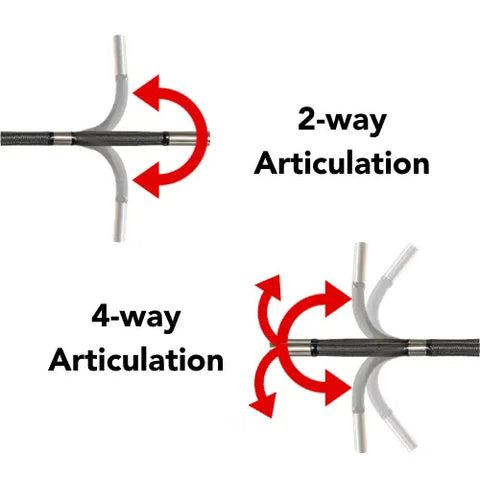When inspecting and accessing tight spaces, having the right video borescope is a must. But with so many different types and sizes of video borescopes available, how do you know which one is best for your application? This guide will help you figure out which features are important when choosing a video borescope, so you can make an informed decision about what's best for your needs.
This Part 1 of a 2-part blog series dicussing how to best choose a video borescope for remote visual inspections (RVI). Read Part 2 on how to best leverage your video borescope during RVI.
Criteria for Choosing the Best Video Borescope
When choosing a video borescope for your application, there are multiple considerations that must be made to select the right tool for the job:
- Inner Diameter of the part opening and core passage being inspected
- Outer Diameter of the video borescope probe
- Direction of view (DoV)
- Field of view (FoV)
- Depth of field (DoF)
- Type of Articulation if any
- Illumination (covered in detail in Part 2 of this blog series)
Inner Diameter (ID)
Simply put, the inner diameter, or ID, refers to the width of the part’s bore or passage being inspected, usually measured in units of inches or millimeters. Knowing your part/application ID dimensions is critical. This is the first consideration in choosing a video borescope as it dictates the OD of the probe needed to perform the inspection.
Different parts and castings may have numerous IDs with some smaller than others. For example, aircraft component inspection frequently inspects titanium turbine blades which may have many small IDs of 1.5 mm or less. This would require a much smaller video borescope than needed in other applications, like larger tubing or sewer/waterline inspection, where ID openings may be up to 25.4 mm (1 inch).
Outer Diameter (OD)
The outer diameter, or OD, of the video borescope is the width of the scope tip. Usually measured in millimeters, this criterion is also critical in choosing the proper scope for your application. Certain ODs of scopes work well with certain part/application ID’s.
Small diameter ODs (2.8 mm and below) tend to be used more often in aerospace/aviation industry inspections, while larger diameter ODs (6.0 mm and above) are more common in inspections and FOSAR opetions in the petrochemical and power generation industries. It's always important to know the ID of the part or component you are inspecting as that is the ultimate deciding factor in choosing the correct video borescope OD.
Direction of View (DOV)

Direction of view (DOV) refers to orientation of the camera sensor on the distal tip of the video borescope. Direct view looks forward (or 0°) from the scope tip, side view looks to the side (or 90°), and dual view can look in either direction. 0° DOV scopes are useful in locating defects inside parts as you maneuver into a part, and 90° DOV scopes are useful for closer side-wall inspection and documentation. Dual view (both 0° and 90°) provides both options for more thorough inspections.
Field of View (FOV)
Field of view (FOV) is the visible area a video borescope can see at once. This is measured in horizontal degrees (H°), or sometimes horizontal by vertical degrees (H° x V°).
As FOV increases, the total area of the image increases. Similarly, as FOV decreases, the total area of the image decreases.
While most video borescopes have a fixed-focus lens (no “zoom” feature), the FOV can help indicate magnification of an image. As FOV increases, objects appear smaller in size, and as FOV decreases, objects appear larger in size. This is best illustrated in the image below:

Depth of Field (DoF)
A video borescope's DoF refers to a range of distance in which its image is in focus. This measurement range is based off the distal tip of the scope as the origin point. The DoF has a minimum and maximum value: the closest the target area will be in focus and the farthest the target area will also still be in focus.

Some DoF's are relatively larger and farther away from the distal tip, like 10 to 100 mm. These are generally set for direct DOV and larger OD video borescopes that are looking down straight tubing to keep more of the picture in focus at once. However, a taget area closer than 10 mm would be out of focus.
Inside a tight space, looking at a side wall of a part or component needs a closer minimum and smaller DoF range. Side DOV and smaller OD video borescopes accommodate this viewing need and have closer minimums and smaller DoF ranges. For example, the Yateks P+ Series Industrial Video Borescope 2.2 mm OD Side View has a DoF of 1 to 20 mm for looking at very close up target areas.
Articulation
Articulation refers to whether a video borescope can move the distal tip of the scope from a simple control mechanism. Some video borescopes are too small to have articulation capability, but technological advances now allow for this capability in video borescopes as small as 1.2 mm OD.
2-way articulation means a scope can sweep back and forth on a single plane. 4-way articulation means a scope can sweep back and forth on 2 separate planes allowing for more inspection coverage without scope rotation. The below illustrates the difference between 2 and 4-way articulation.

Quick Reference: Choosing a Video Borescope
From InterTest’s collective experience in serving customers for over 40 years, the following is a quick reference guide showing examples of video borescope OD’s used to inspect the listed part ID’s.
|
Part/Application ID (in) |
Recommended Video Borescope |
|
< ¼” ID parts |
Cannon Medical SV-2000 0.89, 1.05 & 1.6 mm OD, Direct View, No Articulation |
|
Yateks P+ Series 1.1 mm OD, Direct View, No Articulation Yateks P+ Series 1.7 mm OD, Direct View, 2-way Articulation |
|
|
Zibra Milliscope HDV 1.2 & 1.6 mm OD, Direct View, No Articulation |
|
|
¼” to ½” ID parts |
Yateks P+ Series 2.2 mm OD Direct View, 2-way Articulation |
|
Yateks P+ Series 2.2 mm OD Side View, 4-way Articulation |
|
|
Yateks P+ Series 2.8 mm OD, 4-way Articulation:
|
|
|
Zibra Milliscope HDV 2.6 mm OD, Direct or Side View, No Articulation |
|
|
½” to 1” ID parts |
Yateks P+ Series 3.9 mm OD, 4-way Articulation |
|
1” to 2” ID parts |
Yateks P+ Series 6.0 mm OD, 4-way Articulation |
|
~ 3” to 5” ID parts |
Yateks P+ Series 6.0 mm OD, 4-way Articulation |
|
Yateks P+ Series 8.4 mm OD, Dual View, 4-way Aritculation |
|
| Wohler VIS 700 HD |
This quick reference guide has FOV, DOV, DOF and illumination considerations, but every application will vary. This information is generalized and educational, so let InterTest, Inc. help you choose the best video borescope for you needs.
Contact us immediately and one of our seasoned professionals will ensure you choose the best video borescope for your remote vision inspection application.

